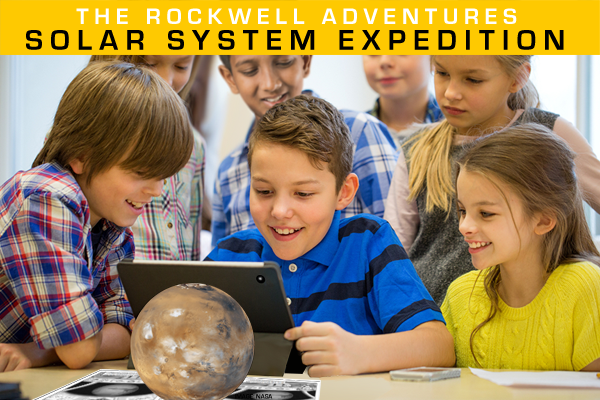The Rockwell Adventures – Solar System Expedition
Join the Rockwell family on their Top Secret mission to colonize a new planet. This fun-filled educational tour of the Solar System teaches students basic facts about each of the planets, and challenges them to design a base that is appropriate for the planet they choose to colonize.

Workbook Overview
What’s Included

Student Activity Books: Professionally printed and bound copies of this STEM-Focused, Augmented Reality enhanced educational activity book.
Teacher’s Manual: PDF versions of the Teacher’s Manual associated with this book. This manual includes easy to print copies of all worksheets that students will consume as part of the lesson.
Lesson Resources
This section contains Teacher’s Manuals for Solar System Expedition, as well as resources that the staff at StoneOak Media, and several collaborating educators have put together to enhance the basic lesson contained in these books. If you’re an educator that has developed extra content supporting these lesson, contact us today. We’re always looking for ways to expand the Solar System Expedition experience!
Pricing & Purchasing Options
Single Book
1 Book
- This book provides everything one student needs to begin exploring the Solar System!
- Use with the FREE Zappar Augmented Reality App
Grade 2-5
25 Book Library Package
- This package provides enough copies so that every student in a standard 25 person elementary classroom can have their own copy.
- Use with the FREE Zappar Augmented Reality App
- Pricing is ($19.95/book) x (25 books) x (10% Discount)
Grade 6-8
30 Book Library Package
- This package provides enough copies so that every student in a standard 30 person middle school classroom can have their own copy.
- Use with the FREE Zappar Augmented Reality App
- Pricing is ($19.95/book) x (30 books) x (10% Discount)
About the Workbook
The Rockwell Adventures – Solar System Expedition is the first book in the Rockwell Adventures Series. Designed for home, classroom, and library use, it takes students on a hands-on tour of the Solar System. State and national curriculum aligned STEM-focused student activities include:

- Measuring Each Planet: Using the FREE Zappar Augmented Reality app for iOS and Android, students are able to scan selected pages of the book to view, interact with, and measure photo-realistic 3D models of each planet. Measurements students record include documenting each planet’s temperature, diameter, and length of day.
- Exploring Each Planet: The adventure doesn’t end there. Using the Zappar Augmented Reality app, students are enabled to send virtual probes to each planet’s surface to better understand conditions there. Additional measurements performed on the surface include determining the surface type (solid, liquid, or gas), and measuring each planet’s gravity relative to Earth’s.
- Designing a Suitable Base: Based on what the students record in their notes after visiting and measuring each planet, they are asked to both choose a planet where they would build a base, and produce a sketch of this base. Students are encouraged to design a base that will be able to accommodate the conditions they previously recorded on the planet they chose.
Test Drive The Mars Tour!
On the page shown below, students are asked to measure various aspects of the planet Mars. Once completed, these measurements are then recorded by the students within the “Exploration Notes” page of the workbook (shown above). At the end of the overall lesson/mission, students are then asked to use these measurements and others as a guide to help them determine which planet they would like to build a base on. Once they’ve selected a planet, these measurements then serve as a guide to help students build the right kind of base.
To try this experience for yourself, simply install the FREE Zappar app (iOS / Android) on a tablet or smartphone, and follow these simple directions:


Customer Reviews
Middle School Teacher in Chicago
We’ve been using this lesson in our class for about 4 years, even during the pandemic. It really is the easiest way to teach students about the Solar System. The students also always get so excited about the design portions. Keep the great products coming!
Produto excelente!
Usei a demonstração gratuita e adorei!! Ótima experiência para os alunos!! Parabéns!
(Translation: I used the free demo and loved it!! Great experience for students!! Congratulations!)
Fantastic Lesson
Primary teacher in Sydney Australia here. My students love this lesson! We’ve used it for several years now, and the students get so excited about learning. We just ordered the Water Cycle books, and can’t wait to try them!
Sugestão
Brazil: Já usei o modelo gratuito com meus alunos e adorei! Gostaria que houvessem mais opções de usar gratuitamente nas escolas públicas do interior
(I’ve used the free template with my students and I loved it! I wish there were more options to use for free in public schools in the interior)
Thank You!!!
Thank you StoneOak Media, for making amazing science products like this available for FREE during the CV-19 crisis. My students, all of who are now learning remotely, have really taken learning to the next level with this book, and Water Cycle Engineer. They’ve been so EXCITED, when I speak with them after these lessons. THANK YOU!!!










